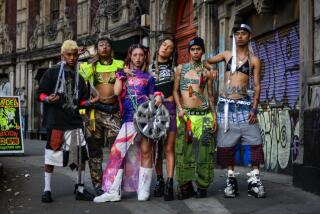Getting at the truth of ‘Exit Through the Gift Shop’
Heading into Sunday’s Academy Awards, “Exit Through the Gift Shop” is undoubtedly the most buzzed-about film in the documentary feature category. But the uncomfortable question persists: Is it real?
The movie is anchored by two of the least reliable narrators in memory: Banksy, the anonymous British street artist; and Thierry Guetta, an eccentric French émigré to Los Angeles whose obsessive filming happens to capture the world of high-concept graffiti. In alternating interviews, the two recount the rise of anti-establishment vandals into the upper echelons of the art world, where their work quickly became commodified.
The twist comes with Guetta’s transformation from the movement’s accidental video scribe into Mr. Brainwash, a street artist phenomenon whose 2008 coming-out party in Los Angeles made him an instant — if completely derivative — success, and whose art now sells in the six figures.
The camera captures it all, sparking speculation about the film’s veracity: Did the clever Banksy — the film’s credited director — create Guetta to mock the art world? Is Guetta — who shot much of the footage — actually a paid actor playing a savant-like character invented for the project? Or, as some have speculated, is he Banksy himself?
Banksy has insisted the film is completely true. But coming from an unidentifiable artist whose work includes titles such as “I can’t believe you morons actually buy this …,” such claims have only fueled the doubts.
Guetta himself, speaking to The Times in his first extended interview since the film was released last spring, said, “This movie is 100% real.”
Over cigarettes and McDonald’s fries at his studio on La Brea Avenue last week, Guetta recounted his path from a rough Parisian suburb to California, where he repeatedly reinvented himself — going from teenage nightclub impresario to clothing store owner, filmmaker and, ultimately, pop artist. If there was one constant, it was Guetta’s uncanny knack for selling Angelenos the cutting edge of cool.
The details of Guetta’s unlikely biography are broadly supported by a review of public records, which trace his life in Los Angeles from his arrival as a teenager in the early 1980s. They are also consistent with the accounts of friends, former business associates and employees over those years.
Of course, it is impossible to prove whether his latest incarnation, Mr. Brainwash, is sincere. The film suggests that Guetta’s artistic alter ego is largely a creation of Banksy, a notion Guetta doesn’t refute.
“Banksy captured me becoming an artist,” the paint-splattered Guetta said, surrounded by the stacks of art books and pop-culture clutter from which his work is derived — or ripped off, depending on your view. “In the end, I became his biggest work of art.”
‘Smart partners’
Guetta was born in 1966 in Garges-lès-Gonesse, a seedy suburb a half-hour drive north of Paris, the youngest of five children of Tunisian Jews who had moved to France to escape persecution.
His mother died when he was a child, and when Guetta was 15, his father moved the family to Los Angeles. Public records show his Social Security number was registered in the early 1980s. For months, they stayed in a cheap hotel on Fairfax Avenue — today’s boutique Farmer’s Daughter Hotel — before settling in a nearby apartment. His father soon returned to France and passed away, leaving Guetta and his siblings to fend for themselves.
He attended Fairfax High for about a year, despite speaking no English. After dropping out, he said he started organizing nightclub parties in Hollywood that became popular with the celebrity set.
“I was trying to be an adult right away,” he recalled.
He also got a job at a vintage clothing store in Venice, starting out on a ladder to keep an eye out for shoplifters. But he showed up early and stayed late, was promoted to manager and eventually bought out the owner, he said.
Between 1985 and the late 1990s, records show Guetta launched a series of businesses with names such as Vintage Supermarket and Rugsaver: The Vintage Shop, his store on La Brea. Guetta said he imported cheap used clothes from France and repackaged them as designer vintage, occasionally selling them as templates to high-end designers like Ralph Lauren.
“Buy for $2, sell it for $200,” he recalled. “We turn trash to gold, and I start making a lot of money.”
He and his brothers also began designing clothes, sewing scraps of jeans into jackets and finishing them with Looney Tunes characters cut out of beach towels. The look took off, Guetta said, and soon they were selling at stores in Los Angeles, New York and Miami.
Eventually, Warner Bros. caught wind of their unlicensed success. But rather than shut them down, Guetta said, the company hired them. The story was confirmed by Warner Brothers, whose consumer products executives recall employing the Guetta brothers to design products sold in the Warner Bros. Studio Store in the 1990s and eventually giving them a merchandising license. The relationship ended around 2006.
“They were credible in that marketplace and they presented themselves as a credible creative and style force in an influential part of the market,” said Barry Ziehl, a spokesman in the consumer product division. “It made them smart partners.”
A compulsion to film
By the late 1990s, Guetta said he had lost interest in clothes and had no shortage of money. Records show he bought a house on Mansfield Avenue, and a commercial property on Fairfax.
He also purchased a video camera and began to film his young children. As “Exit” recounts, the hobby became a full-blown compulsion fueled by a desire to “stop time,” Guetta said, something he traces back to the trauma of his mother’s death.
“He was always filming,” said Maxime Castiel, a friend of Guetta’s at the time. “Everything I saw in the film seems to be more or less true.”
The street art story told in “Exit” essentially begins with Guetta’s 1999 trip to France, where he learns that a cousin is a respected street artist known as Space Invader. Guetta’s camera began chronicling the midnight escapades of Invader and his fellow vandals, including Shepard Fairey, a star in the scene whose iconic OBEY posters could be found plastered on walls around the world.
Guetta’s obsession filled a need for the street artists — he could be trusted to protect their identities while documenting their illicit activities, which were often removed soon after being created. It was always vaguely understood, Guetta said, that the footage would some day become a documentary about the scene.
In 2001, Guetta met Joachim Levy, a Swiss filmmaker, and the two started making edgy videos and websites for corporate clients. Records show Guetta took a $600,000 line of credit in August of that year. A month later, he launched a new business venture — 3E Entertainment.
“Exit’s” producers have said Guetta never watched his hours of street art footage, throwing them into boxes unlabeled. But Levy says that between 2003 and 2006, he helped organize, label, log and edit the tapes into a documentary called “LIFE REMOTE CONTROL,” with Guetta as its credited director.
“If you look at the tapes [shown in “Exit”], they all have elastic banks, they all have labels,” Levy said.
Levy is threatening to sue Banksy — and reveal his identity — unless he is paid and credited for the role he claims he played. Guetta showed The Times several notarized documents that appeared to be signed by Levy, the latest dated 2007. Guetta said they prove Levy was an independent contractor who signed away his rights to the project and promised not to disclose details of his work.
Despite an unvarnished anger for Banksy and Guetta today, Levy nevertheless says the story in “Exit” is almost entirely true.
Enter Banksy
In spring 2006, Guetta finally met the elusive Banksy and that fall helped film his Los Angeles show, Barely Legal, which attracted A-list celebrities and art collectors.
Street art was now being gobbled up for hundreds of thousands of dollars per piece, turning anti-establishment vandalism into an art world commodity. Banksy told Guetta it was time to release the film. Six months later, Guetta arrived in London to show Banksy his final cut of “LIFE REMOTE CONTROL.”
“It was at that point I realized that Thierry maybe wasn’t really a filmmaker,” Banksy says in “Exit,” hidden in shadows and speaking in a digitally disguised voice. “He was maybe just someone with mental problems who happened to have a camera.”
This is where “Exit” takes a mind-bending turn: The artist becomes a filmmaker and the filmmaker becomes an artist. Banksy takes Guetta’s tapes and decides to make the Frenchman the subject of the documentary, sending him back to Los Angeles with instructions to put on an art show — with the camera rolling.
“He gives me a brush and a can, and he took the camera,” Guetta said, adding that Banksy went as far as to tell him what month the show should open. “ ‘Go make your own show and have people filming it.’ ”
Guetta was paid a licensing fee for his footage, according to a representative for the film who refused to elaborate.
Guetta, who had dabbled in art for years, took on his new mission with passion. In June 2007, records show he took out a $320,000 revolving credit line; Guetta confirmed the money was used to pay for the show, which he said he financed alone.
“I put everything I had to make it happen,” he said. “If this didn’t happen, I was going to lose everything.”
By the spring of 2008, Guetta was registering websites to promote the show, and his new alter ego, Mr. Brainwash, began putting up stencils made with the help of Shepard Fairey’s longtime assistant. About the same time, Banksy contacted British television producer Jaimie D’Cruz about making a movie on the rise of street art — seen through the eyes of the unknown Guetta. D’Cruz and his editor, Chris King, were skeptical, but saw potential when they began sifting through Guetta’s tapes.
“Exit” is rather explicit about Banksy’s role engineering the film’s final act: As Mr. Brainwash’s 2008 debut approached, Banksy and Fairey gave him glowing endorsements, instilling him with such instant credibility that the LA Weekly hyped the show with a cover story. When the show fell dangerously behind schedule, Banksy sent in a trusted fixer, Roger Gastman, to whip things into shape. Banksy’s film crew was rolling as hundreds of hipsters lined up to see the debut. And the rest is history.
Since that show, Guetta’s Mr. Brainwash has put on two solo shows in NYC’s meatpacking district, and a third at Art Basel in Miami. In 2009, Madonna’s manager asked him the create cover art for her greatest hits album “Celebration.” He says a large painting of his sold recently for $300,000.
“In the end, Thierry’s a businessman, and his business right now is making art,” said Gastman.
Today, Guetta says he and Banksy remain friends. He refused to comment on whether he’d seen him recently in Los Angeles, and said he has no hard feelings about his humble “camera work” credit on a project based on his decade of compulsive filming. In fact, he credits Banksy for helping him overcome the compulsion.
Mostly, he’s focused on the Oscars, which he plans to attend in a suit by Dolce and Gabbana, which has commissioned his art in the past. As to whether Banksy — whose art has been spotted around L.A. in recent days — will attend the Academy Awards too, Guetta wouldn’t say.
More to Read
The biggest entertainment stories
Get our big stories about Hollywood, film, television, music, arts, culture and more right in your inbox as soon as they publish.
You may occasionally receive promotional content from the Los Angeles Times.










